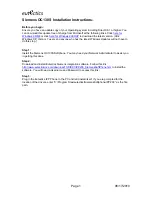
AT-S63 Management Software Features Guide
Section III: Snooping Protocols
213
Restrictions
EPSR snooping has three important restrictions. All the restrictions are
related to control EPSR messages and the fact that EPSR snooping can
not generate these messages.
The AT-9400 Switch cannot fulfill the role of master node of a ring because
EPSR snooping does not generate EPSR control messages. That function
must be assigned to another Allied Telesis switch that supports EPSR,
such as the AT-x900 Advanced Layer 3 Switches. (For a list of Allied
Telesis products that support EPSR, refer to the company’s web site or
contact your sales representative.)
The second restriction is EPSR snooping does not support the transit node
unsolicited method of fault detection. When a break occurs in a ring, the
transit nodes on either side of the break can notify the master node by
sending a “links down” message over the control VLAN of the ring. This
method of fault detection and notification can be a faster way for the
master node to become aware of a problem than with the healthcheck
message. However, since EPSR snooping can not generate the “links
down” message, the AT-9400 Switch can not initiate this type of fault
notification.
The final restriction of EPSR snooping concerns how the switch responds
in the unlikely event it becomes isolated by disruptions in the ring on either
side of it. Because the switch can not generate the EPSR “links up”
message, a failure of a ring at two or more places may leave the AT-9400
Switch and EPSR snooping isolated until all of the breaks have been
repaired and the entirety of the ring is restored.
The problem is illustrated in Figure 18. The example is a ring of four
nodes: a master switch, two transit nodes, and the AT-9400 Switch
running EPSR snooping. The ring has a control VLAN along with one or
more data VLANs. The AT-9400 Switch is isolated from the ring because
of two breaks, one between it and the master node and another between it
and a transit node.
Содержание AT-S63
Страница 14: ...Figures 14 ...
Страница 18: ...Tables 18 ...
Страница 28: ...28 Section I Basic Operations ...
Страница 58: ...Chapter 1 Overview 58 ...
Страница 76: ...Chapter 2 AT 9400Ts Stacks 76 Section I Basic Operations ...
Страница 96: ...Chapter 5 MAC Address Table 96 Section I Basic Operations ...
Страница 114: ...Chapter 8 Port Mirror 114 Section I Basic Operations ...
Страница 116: ...116 Section II Advanced Operations ...
Страница 146: ...Chapter 12 Access Control Lists 146 Section II Advanced Operations ...
Страница 176: ...Chapter 14 Quality of Service 176 Section II Advanced Operations ...
Страница 196: ...196 Section III Snooping Protocols ...
Страница 204: ...Chapter 18 Multicast Listener Discovery Snooping 204 Section III Snooping Protocols ...
Страница 216: ...Chapter 20 Ethernet Protection Switching Ring Snooping 216 Section III Snooping Protocols ...
Страница 218: ...218 Section IV SNMPv3 ...
Страница 234: ...234 Section V Spanning Tree Protocols ...
Страница 268: ...268 Section VI Virtual LANs ...
Страница 306: ...Chapter 27 Protected Ports VLANs 306 Section VI Virtual LANs ...
Страница 320: ...320 Section VII Internet Protocol Routing ...
Страница 360: ...Chapter 30 BOOTP Relay Agent 360 Section VII Routing ...
Страница 370: ...Chapter 31 Virtual Router Redundancy Protocol 370 Section VII Routing ...
Страница 372: ...372 Section VIII Port Security ...
Страница 402: ...Chapter 33 802 1x Port based Network Access Control 402 Section VIII Port Security ...
Страница 404: ...404 Section IX Management Security ...
Страница 436: ...Chapter 36 PKI Certificates and SSL 436 Section IX Management Security ...
Страница 454: ...Chapter 38 TACACS and RADIUS Protocols 454 Section IX Management Security ...
Страница 462: ...Chapter 39 Management Access Control List 462 Section IX Management Security ...
Страница 504: ...Appendix B SNMPv3 Configuration Examples 504 Security Model Security Level Storage Type SNMPv3 Parameters Continued ...
Страница 532: ...Appendix D MIB Objects 532 ...
















































